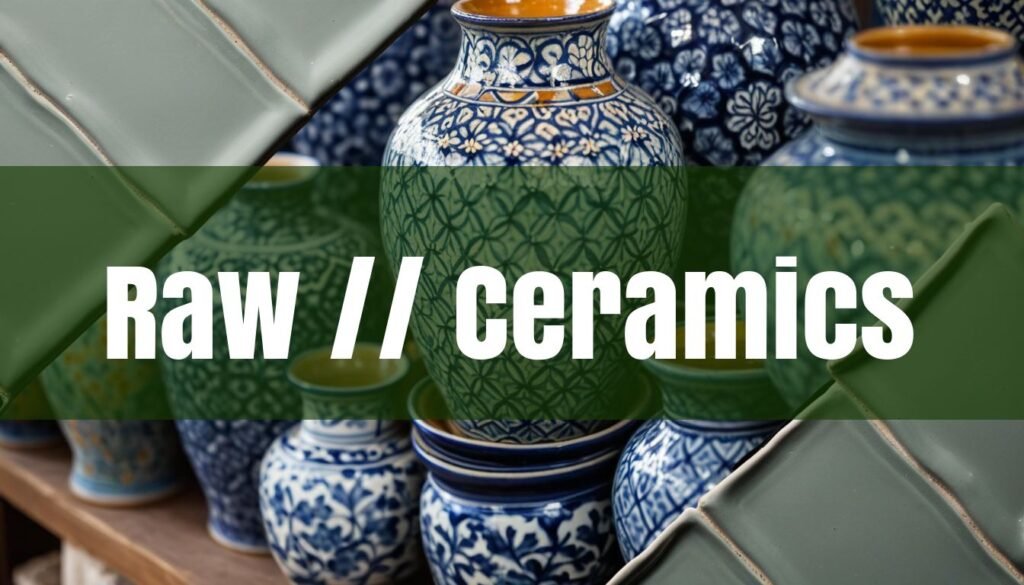Embarking on the journey of painting raw ceramics opens up a world of creative possibilities, allowing you to personalize and adorn pottery with your unique artistic vision. Whether you’re a seasoned ceramicist or a curious beginner, understanding where to source your raw ceramics and how to prepare them for painting is key to achieving stunning, lasting results. Let’s explore the diverse avenues available for acquiring raw ceramics, delve into essential preparation techniques, and navigate potential pitfalls to ensure your painted ceramic creations are both beautiful and durable.
Finding Your Canvas: Sourcing Raw Ceramics
The quest for the perfect raw ceramic piece to paint can lead you down various paths, each offering its own blend of advantages and considerations. Local pottery supply stores stand as invaluable resources, brimming with a diverse selection of clay bodies, tools, and knowledgeable staff ready to guide you. These stores often carry a range of pre-made, unglazed ceramic bisque pieces, from mugs and plates to decorative figurines, providing a tactile experience where you can assess the quality and texture firsthand. While the prices might be slightly higher than online options, the immediate availability and expert advice can be well worth the investment. Online retailers specializing in ceramics offer an expansive marketplace, connecting you with a global network of suppliers and artisans. Websites such as Sheffield Pottery offer dry raw materials used in creating pottery glazes and clay bodies, as well as materials used for a wide range of fine arts including cast sculpture and painting. This option allows you to compare prices, explore niche ceramic styles, and discover unique pieces that might not be available locally. However, keep in mind that you won’t be able to physically inspect the ceramics before purchasing, so carefully review product descriptions and customer reviews. Craft stores with ceramics sections can be a convenient option for beginners or those seeking readily accessible and affordable raw ceramics. These stores typically offer a curated selection of bisque pieces, along with a variety of paints and brushes, making it a one-stop-shop for your ceramic painting needs. While the variety and quality might not match that of specialized pottery supply stores, craft stores can be an excellent starting point for experimenting with ceramic painting without a significant investment. Direct purchases from ceramic artists or studios offer a unique opportunity to acquire handcrafted, one-of-a-kind raw ceramic pieces. By supporting independent artists, you gain access to unique forms and designs, often accompanied by insights into the clay body and firing process. This direct connection can enrich your painting experience, fostering a deeper appreciation for the ceramic arts. However, availability may be limited, and prices might reflect the handmade nature of the pieces. When selecting your raw ceramics, consider the type of clay used, its firing temperature, and the surface texture. Earthenware clay is a popular choice for painting due to its porous nature, which allows paint to adhere well. Ensure that the firing temperature of the clay is compatible with the paints and glazes you intend to use. A smooth, even surface texture will provide an ideal canvas for your artwork, while textured surfaces can add depth and character to your painted designs.
Preparing the Canvas: Essential Surface Preparation Techniques
Before you unleash your inner artist, proper surface preparation is crucial for ensuring optimal paint adhesion and preventing common issues like cracking, peeling, or blistering. Start by thoroughly cleaning the raw ceramic piece to remove any dust, dirt, or oils that may hinder paint adhesion. A moist cloth works well for this purpose. For pieces that have been previously glazed, lightly sanding the surface with fine-grit sandpaper can create a slightly rougher texture, providing a better grip for the paint. After sanding, wipe away any residual dust with a clean cloth. Priming the ceramic surface is a critical step that creates a uniform base for the paint, enhancing its adhesion and longevity. Choose a primer specifically designed for ceramics or multi-surface use, and apply it in thin, even coats, allowing each coat to dry completely before applying the next. Primers help hold the paint in place on your ceramic. For raw clay pieces that are bone dry, handle them with care to avoid marring the surface. Graphite from pencils used for transferring designs can be easily removed with a damp sponge and burns off completely in the kiln. Remember that underglaze adheres better if pencil lines are left unpainted. By investing time and care in surface preparation, you create a solid foundation for your painted ceramic artwork, minimizing potential problems and maximizing the vibrancy and durability of your designs.
Proper surface preparation is crucial for ensuring optimal paint adhesion.
Palette and Process: Paints, Glazes, and Firing Best Practices
Selecting the right paints and glazes is essential for achieving your desired aesthetic and ensuring the longevity of your painted ceramics. Acrylic paints are a versatile and popular choice for painting raw ceramics, offering excellent adhesion, vibrant colors, and ease of use. Most acrylic paints are also non-toxic, making them suitable for functional pieces like mugs and bowls. Latex paints are another water-based option, while enamel paints provide an oil-based alternative. For a more traditional ceramic approach, consider using underglazes, slips, and oxide stains, which fuse to the clay body when fired to maturity. These materials offer a range of effects, from watercolor-like washes to bold, painterly strokes. China paints, typically used on glazed porcelain, require mixing with oil and are applied in layers with firing between each stage. Once your raw ceramic piece is painted, firing is necessary to permanently set the colors and create a durable, food-safe surface. The firing temperature should be carefully matched to the clay body and the paints or glazes used. It is important to match the firing temperature of the glaze to the maturing temperature for the particular clay body.
Pots must be completely dry before firing, otherwise the steam escaping could cause them to explode. A slow, controlled firing schedule is crucial to prevent cracking or other damage to the ceramic piece. During the firing process, organic matter in the clay is burned and oxidized to carbon dioxide, and fluorine and sulphur dioxide from materials in the clay body are driven off at 1292–1652°F (700–900°C). Allow the kiln to cool down gradually before opening it, as rapid cooling can also cause cracking. By carefully selecting your paints and glazes and following recommended firing practices, you can transform your painted raw ceramics into enduring works of art.





